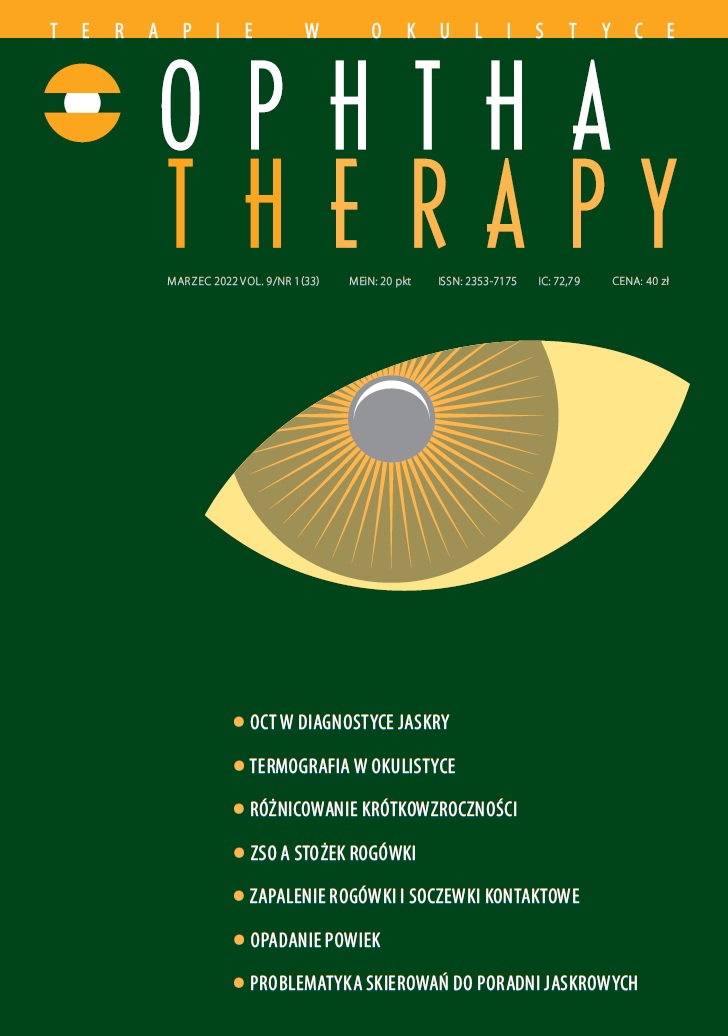Contact lens-related combined Pseudomonas aeruginosa, Acanthamoeba and Candida keratitis among adolescents girls Case series report
Main Article Content
Abstract
Background: We present a case of combined Pseudomonas aeruginosa, Acanthamoeba and Candida keratitis and clinical course of treatment in two adolescents girls who did not follow the rules of proper use of soft contact lenses.
Case reports: Two teenage contact lens users sought medical attention, reporting visual impairment, redness and pain of the eye. Slit lamp examination showed unilateral corneal ulcer. Confocal microscopy revealed images compatible with amoebic cysts and yeasts cells, whereas the results of conjunctival swabs confirmed the presence of Pseudomonas aeruginosa. After topical and general treatment in the first patient, the corneal defect was healed, and visual acuity improved. The girl remains under the constant supervision of an ophthalmological clinic. The medications were gradually reduced, but with time she developed crystalline keratopathy. Regrettably, the second patient, despite the applied treatment had recurrent inflammation and progressive corneal thinning, which required amniotic membrane transplantation to prevent perforation.
Conclusion: The early identification of the pathogen as well as adequate treatment is crucial, as contact lens-associated keratitis are potentially sight threatening. Patient and caregiver education, adequate contact lens hygiene and consistent follow-up are important to prevent serious complications.
Downloads
Article Details

This work is licensed under a Creative Commons Attribution-NonCommercial-NoDerivatives 4.0 International License.
Copyright: © Medical Education sp. z o.o. License allowing third parties to copy and redistribute the material in any medium or format and to remix, transform, and build upon the material, provided the original work is properly cited and states its license.
Address reprint requests to: Medical Education, Marcin Kuźma (marcin.kuzma@mededu.pl)
References
2. Alipour F, Khaheshi S, Soleimanzadeh M et al. Contact Lens-related Complications: A Review. J Ophthalmic Vis Res. 2017; 12(2): 193-204. http://doi.org/10.4103/jovr.jovr_159_16.
3. Dart JK, Radford CF, Minassian D et al. Risk factors for microbial keratitis with contemporary contact lenses: a case-control study. Ophthalmology. 2008; 115(10): 1647-54, 1654.e1-3. http://doi.org/10.1016/j.ophtha.2008.05.003.
4. Stapleton F, Edwards K, Keay L et al. Risk factors for moderate and severe microbial keratitis in daily wear contact lens users. Ophthalmology. 2012; 119(8): 1516-21. http://doi.org/10.1016/j.ophtha.2012.01.052.
5. Sy A, Srinivasan M, Mascarenhas J et al. Pseudomonas aeruginosa keratitis: outcomes and response to corticosteroid treatment. Invest Ophthalmol Vis Sci. 2012; 53(1): 267-72. http://doi.org/10.1167/iovs.11-7840.
6. Twining SS, Davis SD, Hyndiuk RA. Relationship between proteases and descemetocele formation in experimental Pseudomonas keratitis. Curr Eye Res. 1986; 5(7): 503-10. http://doi.org/10.3109/02713688608996372.
7. Stewart PS, Costerton JW. Antibiotic resistance of bacteria in biofilms. Lancet. 2001; 358(9276): 135-8. http://doi.org/10.1016/s0140-6736(01)05321-1.
8. Hilliam Y, Kaye S, Winstanley C. Pseudomonas aeruginosa and microbial keratitis. J Med Microbiol. 2020; 69(1): 3-13. http://doi.org/10.1099/jmm.0.001110.
9. Lakhundi S, Siddiqui R, Khan NA. Pathogenesis of microbial keratitis. Microb Pathog. 2017; 104: 97-109. http://doi.org/10.1016/j.micpath.2016.12.013.
10. Tu EY, Joslin CE, Sugar J et al. Prognostic factors affecting visual outcome in Acanthamoeba keratitis. Ophthalmology. 2008; 115(11): 1998-2003. http://doi.org/10.1016/j.ophtha.2008.04.038.
11. Clarke DW, Niederkorn JY. The pathophysiology of Acanthamoeba keratitis. Trends Parasitol. 2006; 22(4): 175-80. http://doi.org/10.1016/j.pt.2006.02.004.
12. Maycock NJ, Jayaswal R. Update on Acanthamoeba Keratitis: Diagnosis, Treatment, and Outcomes. Cornea. 2016; 35(5): 713-20. http://doi.org/10.1097/ICO.0000000000000804.
13. Al-Badriyeh D, Leung L, Davies GE et al. Successful Use of Topical Voriconazole 1% Alone as First-Line Antifungal Therapy Against Candida albicans Keratitis. Ann Pharmacother. 2009; 43(12): 2103-2107. http://doi.org/10.1345/apn.1M318.
14. Qiao GL, Ling J, Wong T et al. Candida Keratitis: Epidemiology, Management, and Clinical Outcomes. Cornea. 2020; 39(7): 801-5. http://doi.org/10.1097/ICO.0000000000002306.
15. Jurkunas UV, Langston DP, Colby K. Use of voriconazole in the treatment of fungal keratitis. Int Ophthalmol Clin. 2007; 47(2): 47-59. http://doi.org/10.1097/IIO.0b013e318036bd47.
16. Gorlin AI, Gabriel MM, Wilson LA et al. Effect of adhered bacteria on the binding of Acanthamoeba to hydrogel lenses. Arch Ophthalmol. 1996; 114(5): 576-80. http://doi.org/10.1001/archopht.1996.01100130568013.
17. O’Day DM, Head WS. Advances in the management of keratomycosis and Acanthamoeba keratitis. Cornea. 2000; 19(5): 681-7. http://doi.org/10.1097/00003226-200009000-00013.
18. Mohammadpour M, Sabet FA. Long-term Outcomes of Amniotic Membrane Transplantation in Contact Lens Induced Pseudomonas Keratitis with Impending Corneal Perforation. J Ophthalmic Vis Res. 2016; 11(1): 37-41. http://doi.org/10.4103/2008-322X.180712.
19. Resch MD, Resch BE, Csizmazia E et al. Permeability of human amniotic membrane to ofloxacin in vitro. Invest Ophthalmol Vis Sci. 2010; 51(2): 1024-7. http://doi.org/10.1167/iovs.09-4254.
20. Resch MD, Resch BE, Csizmazia E et al. Drug reservoir function of human amniotic membrane. J Ocul Pharmacol Ther. 2011; 27(4): 323-6. http://doi.org/10.1089/jop.2011.0007.
21. Chalmers RL, Wagner H, Mitchell GL et al. Age and other risk factors for corneal infiltrative and inflammatory events in young soft contact lens wearers from the Contact Lens Assessment in Youth (CLAY) study. Invest Ophthalmol Vis Sci. 2011; 52(9): 6690-6. http://doi.org/10.1167/iovs.10-7018.

